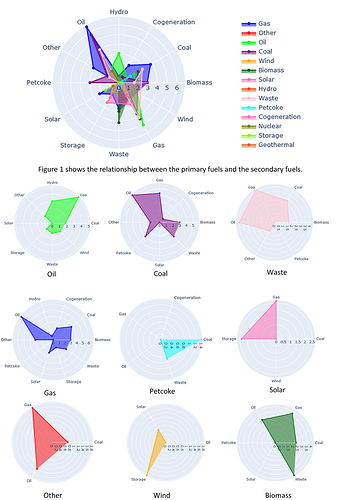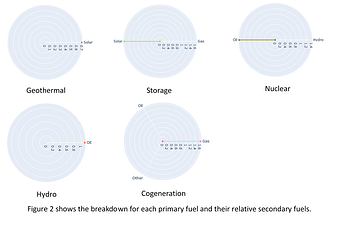Hi everyone,
Hope you are having a great day. Inspired by [1], I am trying to find the relationship between the primary fuel sources and its secondary fuel sources (i.e. what secondary fuel is likely to occur given the primary fuel) using radar charts. There are two figures below, the first one showing the overall plot of the primary fuel sources against their secondary fuel sources and the second figure showing the breakdown of each primary fuel source.
Image:
Visual Design Type : Radar Chart
Name of Tool : Plotly and Matplotlib
Country : All countries
Year : All years
Visual Mappings :
The axis of the radar chart provides one axis for each secondary fuel source (hydro, cogeneration, coal, biomass, wind, gas, waste, storage, solar, petcoke, other and oil). The colour shows the type of primary fuel sources. The shape and size allow us to see which secondary fuel source is related to the primary fuel source (i.e. how likely is the secondary fuel source to occur given the primary fuel source). The bigger the area/shape, the more the correlation between the primary fuel source and its secondary fuel sources.
Unique Observation : From the radar chart, we can see that most of the non-renewable energy like coal, oil and gas are correlated to one and another.
Data Preparation : The dataset is filtered so that it does not include any null values. For each primary fuel source, the sum of each secondary fuel source is calculated. The axis of the radar is then calculated by getting the maximum and the minimum counts secondary fuel source respective to their primary fuel sources. As the maximum for certain primary fuel sources such as Coal, Oil and Gas are higher than most of the other primary fuel sources, we used the logarithmic function to normalize the radar.
Source : Global Power Plant Database - Datasets - WRI ODP
References:
[1] Holtz, Y. (n.d.). The Radar Chart and Its Caveats . Retrieved from from Data to Vis: The Radar chart and its caveats
[2] Christian Partl, P. P. (n.d.). Star Plots: A Literature Survey. Retrieved from https://courses.isds.tugraz.at/ivis/surveys/ss2010/g4-survey-starplots.pdf
Questions :
- Is the choice of colour appropriate? As there are too many colours (primary fuel sources), it might be hard to understand the visualisation.
- Should I get rid of the primary fuel sources that have smaller number of secondary fuel sources such as Geothermal, Storage, Nuclear, Cogeneration and Hydro?
- Is there any suggestions that I can further improve on my data visualisation?
Thank you for reading and your suggestions are much appreciated! ![]()

